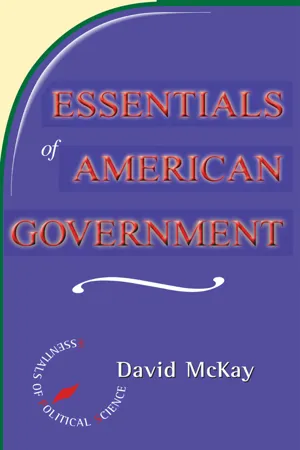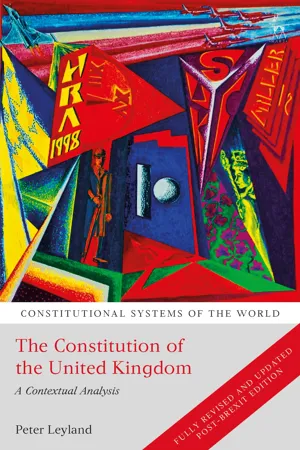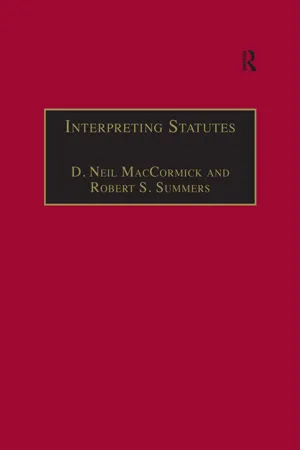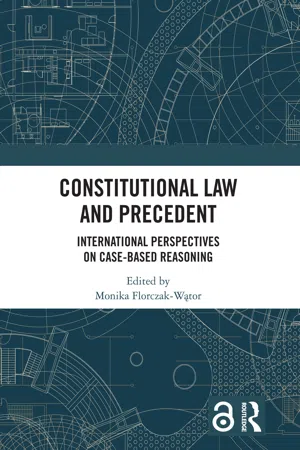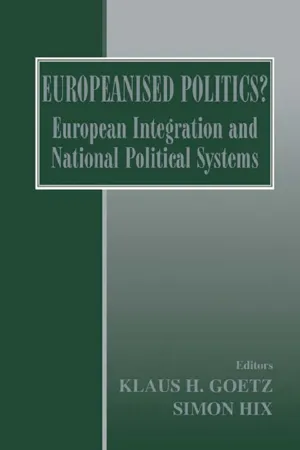Politics & International Relations
Supreme Court UK
The Supreme Court of the United Kingdom is the highest court in the country, established in 2009 to replace the Appellate Committee of the House of Lords. It hears cases of the greatest public or constitutional importance, and its decisions are final. The court plays a crucial role in interpreting and upholding the rule of law in the UK.
Written by Perlego with AI-assistance
Related key terms
9 Key excerpts on "Supreme Court UK"
- eBook - ePub
- Ian Budge, David Mckay, Kenneth Newton, John Bartle(Authors)
- 2013(Publication Date)
- Routledge(Publisher)
The CRA states that the Lord Chancellor will no longer sit as a judge, will no longer exercise judicial functions and must have certain qualifications (exactly what these are is decided by the Prime Minister). Many of the Lord Chancellor’s remaining functions will be transferred to the Lord Chief Justice or other senior judges. The CRA imposes a duty on ministers to uphold the independence of the judiciary by not seeking to influence their decisions via their ‘special access’ and places a special duty on the Lord Chancellor to support the judges. It also gives the Lord Chief Justice the ability to make representations to Parliament on any matter relating to administration of justice.In July 2006, Baroness Hayman became the newly elected chair of the Lords. With these reforms in place the UK will have a clearer separation of powers. Physical distance from Parliament may also subtly alter the relationship between the judiciary and the executive and make the former more assertive.The political role of the courts
The growing recourse to legal action to resolve political disputes means that the higher courts have an important role mediating between:- individuals and all branches of government
- central and local government
- British central and local government and the European Union.
Conservative legislation of the 1980s, particularly the laws regulating industrial relations and trade union activities, extended the supervisory and decision-making powers of the courts into new areas, where they often find themselves in conflict with powerful political interests.All this has happened in a system where the courts lack what has often been taken as the distinguishing mark of a ‘political’ jurisdiction, that is, the power of ‘constitutional review’. Constitutional review in its layperson’s sense means a system in which laws and other acts of the legislature can be overruled by a court if they are held to conflict with constitutional rules, basic human rights or any other laws treated as superior to ordinary legislation. In Marbury v Madison (1803), for example, the Supreme Court decided that it could invalidate those Acts of Congress or the state legislatures that contradicted the constitution. Courts with similar powers exist in Canada, Australia and Germany among other countries and, as we have seen in the Factortame case (1993) in Chapter 4 - eBook - ePub
- David Mckay(Author)
- 2018(Publication Date)
- Routledge(Publisher)
12The Supreme Court and Judicial PoliticsWe are very quiet there but it is the quiet of a storm center.—Oliver Wendell Holmes, Associate Justice of the Supreme Court, 1902–1932In a democracy, politics is a process of popular education—the task of adjusting the conflicting interests of diverse groups,… and thereby the hostility and suspicion and ignorance engendered by group interests… toward mutual understanding.—Felix Frankfurter, Associate Justice of the Supreme Court, 1939–1962In all societies, the courts play some political role. In liberal democracies where the independence of the judiciary is regarded as essential to prevent the exercise of irresponsible executive (and sometimes legislative) power, the political role of the courts as interpreters of the law and as defenders of individual freedoms is well established. In despotic and one-party states, courts are political in the quite different sense that they are the instruments of a dominant executive.However, there are also important distinctions within liberal democratic states, the most crucial being the presence or absence of judicial review. As was noted in Chapter 3 , judicial review is long established in the United States, and the Supreme Court is the final arbiter of the meaning of the Constitution. Hence, all laws passed by the state and national legislatures, together with all executive actions, are subject to review by the courts, which judge their compatibility with the Constitution. As the final court of appeal, therefore, the Supreme Court has the legal power to declare any action by any other branch of government unconstitutional.This apparently formidable power is tempered by a number of factors, but in contrast to many other liberal democracies, the United States has a system that entails enormous potential judicial power. In the United Kingdom, for example, the courts can review executive actions—but only by testing them in relation to the content of acts of Parliament. This can produce sharp rebukes for governments when the courts judge that the government has acted ultra vires (beyond its powers), and the British courts are becoming more active in reviewing executive actions. A British Parliament controlled by the executive can, however, always reverse a judicial judgment, as sovereignty lies not in the Constitution but in Parliament. In the United States, a decision of the Supreme Court involving the constitutionality of a statute or governmental action can be overturned only by constitutional amendment (or by the Court itself, of course), and as was shown in Chapter 3 - eBook - ePub
The Constitution of the United Kingdom
A Contextual Analysis
- Peter Leyland(Author)
- 2021(Publication Date)
- Hart Publishing(Publisher)
In fact, the position has been exactly the reverse in regard to the US Supreme Court. The US Supreme Court exercises a constitutional review function and, unlike the UK courts, it has the power to oversee the constitution and to declare legislation invalid. This has projected the Court into the forefront of political controversy on many occasions. 40 Most obviously in recent times it was the US Supreme Court that finally had to decide the validity of the contested presidential election result in the year 2000 in the case of Bush v Gore. 41 The political dimension of the Supreme Court’s role has resulted in deliberate attempts by US Presidents to select judicial candidates with views that appear to correspond to their own. 42 An obvious danger in making any such reform in the UK to the system of judicial appointments was introducing any form of political interference into the process. The central objection made by Professor Griffith to the types of appointments to the judicial bench during the 1970s and 1980s concerned the elevation to the higher judiciary of a public school Oxbridge-educated elite section of society, nearly all of whom had experienced a similar legal training. 43 Contemporary critics such as Lady Hale no longer view the problem mainly in terms of social class, but rather identify the need to appoint judges who are more representative of society as a whole. 44 LCs have increasingly recognised the importance of placing increasing emphasis on equality and diversity as well as the accepted qualities of integrity and judicial quality understood in terms of intellectual ability. 45 Despite the changes to the appointments system discussed below, and close monitoring of who is appointed, there is still an under-representation of women and ethnic minorities at the highest judicial - Peter Joyce(Author)
- 2015(Publication Date)
- Teach Yourself(Publisher)
Minor civil matters may be handled by the small claims procedure, which seeks to resolve a dispute without the need to take it to open court. Most civil cases that go to court are heard by county courts, although the High Court of Justice may hear cases in which large sums of money are claimed. Appeals against a verdict reached in a County Court or the High Court will be heard by the Court of Appeal (Civil Division).Scotland has a legal system which is different from that in England and Wales, and the courts in Northern Ireland also function differently from their English and Welsh counterparts. INTERNATIONAL COURTS WITH JURISDICTION IN THE UKThe House of Lords formerly acted as the final Court of Appeal for both criminal and civil cases. The 2005 Constitutional Reform Act replaced the jurisdiction of the House of Lords with a new body, the Supreme Court, which became operational in 2009. This Court is composed of 12 justices and hears appeals on points of law for all civil cases in the UK and relating to criminal cases in England, Wales and Northern Ireland. It also adjudicates on devolution issues arising from the 1998 and 2012 Scotland Acts, the 1998 Northern Ireland Act, and the 2006 Government of Wales Act.There are two European courts with the power to overrule decisions made by British courts of law. These are the European Court of Justice and the European Court of Human Rights.The International Criminal Court is responsible for trying cases related to genocide, crimes against humanity, and war crimes committed anywhere in the world. It was created in 1998 and became operational in 2002. Individual nations are required to endorse its operations through a process of ratification which, in the case of the UK, was the 2001 International Criminal Court Act.• The European Court of Justice (ECJ) / Court of JusticeThis Court is staffed by 25 judges and 8 advocates drawn from member countries of the EU, who serve for 6 years. It was established in 1952 and its main purpose is to ensure that EU law is adhered to within member countries. Disputes between states, between the EU and member states, between individuals and the EU, or between the institutions of the EU are all referred to this Court. It has the power to declare unlawful any national law that contravenes EU law, and also has the power to fine companies in breach of this legislation.- eBook - ePub
- Hilaire Barnett(Author)
- 2019(Publication Date)
- Routledge(Publisher)
One constitutional curiosity which represented a challenge to the separation of powers was the existence of the highest court in the United Kingdom, the Appellate Committee of the House of Lords, sitting in Parliament. Judges elevated to the highest court were made Life Peers under the Appellate Jurisdiction Act 1876, and known as Lords of Appeal in Ordinary, or Law Lords. The Court was physically located in committee rooms of the House of Lords, and judgments were delivered in the chamber of the House of Lords where its legislative work is carried out. The judges also contributed to the legislative work of the House of Lords, further blurring the line between the judiciary and the legislature. The arrangement can only be understood by reference to the constitutional convention which regulated the relationship between the judges sitting in their judicial capacity and the judges participating in the law-making work of the House of Lords. Convention dictated that – in order to protect their independence and impartiality – judges would not participate in party political debate.The Constitutional Reform Act 2005 remedied this anomalous situation by creating a Supreme Court physically removed from the Houses of Parliament.10 Housed in Middlesex Guildhall, opposite the Houses of Parliament, the Supreme Court represents an improved separation of powers between Parliament and the judiciary and complements the reformed office of Lord Chancellor. Although the name ‘Supreme Court’ was adopted, the Court was not given additional powers and is not comparable to a Supreme Court under a written constitution. Accordingly, it has the same powers as the Appellate Committee of the House of Lords, and – as previously – has no power to invalidate Acts of Parliament.The Justices of the Supreme Court sit in panels of five, seven, nine or 11 Justices. Proceedings are open to the public.The Relationship Between Executive and Legislature; Legislature and Judiciary; Executive and Judiciary
‘In the field of constitutional law the delicate balance between the various institutions … is maintained to a large degree by the mutual respect which each institution has for the other’. [Lord Hope of Craighead, Jackson v Attorney General (2005) at paragraph 125]In order to evaluate the separation of powers under the contemporary constitution, it is necessary to evaluate the manner in which, and the extent to which, separate functions are allocated between the differing bodies and kept separate. This task is most conveniently undertaken by examining the relationship between first, the executive and legislature, second, the legislature and judiciary and, third, the executive and judiciary. - eBook - ePub
Interpreting Statutes
A Comparative Study
- D. Neil MacCormick, Robert S. Summers(Authors)
- 2016(Publication Date)
- Routledge(Publisher)
10 Statutory Interpretation in the United Kingdom ZENON BANKOWSKI, Edinburgh, AND D. NEIL MacCORMICK, Edinburgh Preliminary The United Kingdom consists of three legal systems, to varying degrees distinct: those of Northern Ireland, England and Wales, and Scotland. They exist, for various historical, political and cultural reasons, within the context of a unitary state. We do not have a federal system. For all three systems the supreme civil court is the same, namely the Judicial Committee of the House of Lords. For Northern Ireland and England this is the supreme criminal court; but in Scotland the High Court of Justiciary, acting as a criminal appeal court, is the final instance in matters criminal. Where appeals to the House of Lords are comretent, these are all by leave (that is, selective). The current annua case-load is about 70 cases per year. There is a single legislative authority for all jurisdictions, viz., the United Kingdom Parliament. Statutes either apply to all juris dictions or it is specifically noted to which jurisdiction they apply or which jurisdictions are excluded. Within each jurisdiction the system of stare decisis binds courts at inferior levels in the hierarchy but decisions at the same level are not binding. Though precedents outwith the jurisdiction but within the country are not binding they are persuasive and, because of the common supreme courts, there is a great deal of intermingling. In interpretation of statutes this is more so, since many of the statutes are common - eBook - ePub
Constitutional Law and Precedent
International Perspectives on Case-Based Reasoning
- Monika Florczak-Wątor, Monika Florczak-Wątor(Authors)
- 2022(Publication Date)
- Routledge(Publisher)
74 Today, such an approach is unnecessary and highly unlikely, considering the reluctance of American judges to follow the rulings of exterior courts.According to the Constitution, international treaties are positioned high in the hierarchy of sources of law, just below the Constitution, and on the same level as the acts of Congress75 . However, constitutional practice indicates a smaller impact of international legal norms on both the federal legislation and the Court’s jurisprudence. Historically, there were certain initiatives in Congress which aimed at limiting the impact of international treaties on U.S. legislation, and, at the same time, the Court rarely took a position on the scope of government powers concerning foreign policy-related issues.76 If the justices adjudicated in disputes concerning the relations between international and domestic law, they usually focused on the scope of powers of the President and Congress with respect to foreign policy matters, supporting the growing impact of the executive in that respect, especially in national security matters.77 Recently, however, the Court had an opportunity to discuss the character and applicability of international legal norms in the U.S. legal system. Controversies over the position of international law in U.S. the legal system were ignited after the SCOTUS decision in Medellin v Texas,78 a 2008 case concerning the right to consul of a Mexican national who was found guilty of a murder in Texas and sentenced to death. Although the U.S. was the party of international agreements guaranteeing the right to consul in such circumstances, Medellin’s right was rejected, and he was later found guilty by state courts. Because there were more foreign nationals who were tried by U.S. courts without exercising their right to consul, all of these cases were brought to the International Court of Justice, which declared in 2004 that the U.S. was bound by international agreements which provided the right to consul for foreign nationals,79 As a consequence, Medellin’s case was brought to the SCOTUS and the justices had an opportunity to express their reflection on the relation between international and domestic law. The conservative majority declared that not all international treaties were directly binding, and, therefore, that they needed congressional legislation in order to become a binding element of the U.S. legal system. Furthermore, the Court stated that decisions of the International Court of Justice do not have to be followed by American courts. Such an approach strengthened the arguments about the reluctance of U.S. judges to follow the rulings of international courts, even if the liberal dissenters in Medellin - eBook - ePub
- David McKay(Author)
- 2017(Publication Date)
- Wiley-Blackwell(Publisher)
In addition, the United States is infused with constitutionalism. With a written constitution granting certain rights and freedoms to citizens, delineating a separation of powers and guaranteeing a federal system of government, disputes between individuals and government, and between branches and levels of government, must be arbitrated. Of course, in every political system disputes of this sort have to be resolved, but in few systems are rather rigidly delineated citizens’ rights, separation of powers and federal arrangements married to a strong tradition of legalism and the institution of judicial review. As far as the political role of the courts is concerned, it is the presence of judicial review that marks out the American system as distinctive, and as the Supreme Court is the highest court in the land, it is the Court’s judicial review function that has attracted the most attention. The bulk of this chapter is therefore devoted to this subject. Specifically, the chapter examines how the Court has responded to the much more confrontational political environment of the twenty-first century and in particular how judicial decisions affect other actors in the political system, including Congress, the presidency and the states.The American Legal System
For the vast majority of Americans, state courts are what matter, for of the approximately 10 million cases tried in the United States every year, the federal courts account for fewer than 2 per cent. State, municipal, county and other local courts have jurisdiction over state law – which means that in any one state the vast majority of criminal and civil law cases, from mugging to property disputes, from divorce to homicide, are initiated and concluded within the state system. Almost all of the more sensational criminal and civil cases, such as the trials of O. J. Simpson (the ex-professional footballer accused and acquitted of killing his ex-wife and her boyfriend in 1995, but later in 2008 convicted of armed robbery) and the Menendez brothers (convicted of killing their parents to inherit their estate), start and end in state rather than federal courts. For most of the time, therefore, the two systems operate independently of one another. As can be seen from figure 15.1 - eBook - ePub
Europeanised Politics?
European Integration and National Political Systems
- Klaus H. Goetz, Simon Hix(Authors)
- 2012(Publication Date)
- Routledge(Publisher)
The Positioning of EU Judicial Politics within the United Kingdom
Damian Chalmers DOI: 10.4324/9780203045534-8Any lawyer can, at best, be ambivalent about the study of judicial politics. The treatment of courts ‘as one governmental agency among many–as part of the … political process rather than as a unique body of impervious legal technicians above and beyond the political struggle’1 suggests a supreme disinterest in the epistemic foundations of law. This heavy instrumentalisation, by reducing courts to simple agents of the political process, can offer little instruction in the grammar codes of legal knowledge, processes and discourse. Yet it is the internalisation of these by participants that forecloses certain options and provides a certain resistance to, and therefore autonomy from, outside pressures–in essence, those very legal qualities that lead political or other actors to resort to law. For this author, at least, ambivalence is not synonymous with dismissal. The autonomy of the political system imposes external constraints upon the operation of the law and, whilst the judicial system may be autonomous, it is not autarkic. It will often be used instrumentally by political actors. Indeed, a feature of the legal system is that it is particularly vulnerable to these outside pressures. For its quest for formal and functional effectiveness leads not just to a concern with the problem of compliance, but also to a desire to ‘perfect’, and therefore be sensitive to, the properties of the political processes, domestic and European Union (EU), that it regulates. The insights offered by judicial politics lie precisely on this apex in its strong focus upon the process of negotiation and adjustment between the judiciary, other agencies of government and the wider political sphere.Judicial politics studies have a particular strong resonance in the case of the judicial system of the EU. The dependence of the European Communities' (EC) legal system upon a variety of national governmental agencies for its implementation, enforcement and much of its application has led to concerns about its formal effectiveness; at the same time, its relatively inchoate and ‘young’ nature has rendered it particularly vulnerable to charges of being excessively disruptive. These structural features have been exacerbated by the activities of the European Court of Justice (ECJ). It has both developed relationships with national courts and litigants that, in functional terms, have acted as surrogate policy processes at the expense of national governments,2 and, through its constitutionalist case law, placed itself at the centre of all debates about the civil and political identity of the Union. These have raised expectations about the capability of EC law to exert compliance and about the demands in terms of liberal values that can be exerted by it,3
Index pages curate the most relevant extracts from our library of academic textbooks. They’ve been created using an in-house natural language model (NLM), each adding context and meaning to key research topics.

